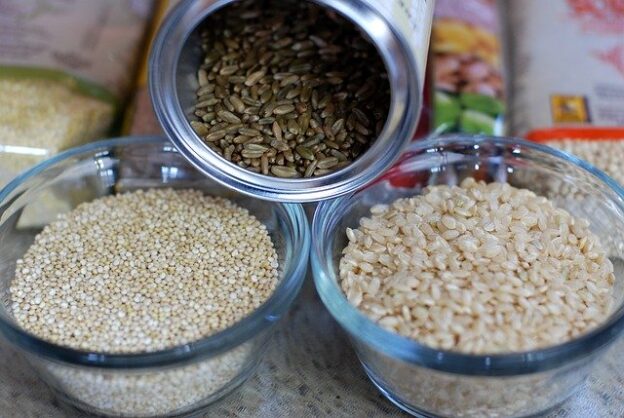Brief Overview: Whole grains are apart of the Plant-based diet, Whole Grains Were Often Eaten in Times of Hardship, The Book of Ezekiel is one of the most detailed and well-known references to grains, as God commands Ezekiel to use “wheat and barley, and beans and lentils, and millet and spelt” to make bread for the people to eat. Ezekiel 4: 9
Eating grains, especially whole grains provides health benefits. People who eat whole grains as part of a healthy diet have a reduced risk of some chronic diseases. Grains provide many nutrients that are vital for the health and maintenance of our bodies.
Whole grains include grains like wheat, corn, rice, oats, barley, quinoa, sorghum, spelt, rye – when these foods are eaten in their “whole” form Whole grains even include popcorn!
Health experts advise everyone – men and women, young and old – that grains are a healthy necessity in every diet, and that it’s important to eat at least half our grains as “whole grains.”
What is a Whole Grain
All grains start life as whole grains. In their natural state growing in the fields, whole grains are the entire seed of a plant. This seed (which industry calls a “kernel”) is made up of three key edible parts – the bran, the germ, and the endosperm – protected by an inedible husk that protects the kernel from assaults by sunlight, pests, water, and disease.
THE BRAN
The bran is the multi-layered outer skin of the edible kernel. It contains important antioxidants, B vitamins and fiber.
THE GERM
The germ is the embryo which has the potential to sprout into a new plant. It contains many B vitamins, some protein, minerals, and healthy fats.
THE ENDOSPERM
The endosperm is the germ’s food supply, which provides essential energy to the young plant so it can send roots down for water and nutrients, and send sprouts up for sunlight’s photosynthesizing power. The endosperm is by far the largest portion of the kernel. It contains starchy carbohydrates, proteins, and small amounts of vitamins and minerals.
WHOLE GRAINS ARE HEALTHIER because whole grains contain all three parts of the kernel. Refining normally removes the bran and the germ, leaving only the endosperm. Without the bran and germ, about 25% of a grain’s protein is lost, and are greatly reduced in at least seventeen key nutrients. Processors add back some vitamins and minerals to enrich refined grains, so refined products still contribute valuable nutrients. But whole grains are healthier, providing more protein, more fiber and many important vitamins and minerals.
Nutrients
- Grains are important sources of many nutrients, including complex carbohydrates, dietary fiber, several B vitamins (thiamin, riboflavin, niacin, and folate), and minerals (iron, magnesium, and selenium).
- Dietary fiber from whole grains or other foods may help reduce blood cholesterol levels and may lower the risk of heart disease, obesity, and type 2 diabetes. Fiber is important for proper bowel function. It helps reduce constipation and diverticulosis. Fiber-containing foods such as whole grains help provide a feeling of fullness with fewer calories.
- The B vitamins thiamin, riboflavin, and niacin play a key role in metabolism – they help the body release energy from protein, fat, and carbohydrates. B vitamins are also essential for a healthy nervous system. Many refined grains are enriched with these B vitamins.
- Folate (folic acid), another B vitamin, helps the body form red blood cells. Women of childbearing age who may become pregnant should consume adequate folate from foods and in addition 400 mcg of synthetic folic acid from fortified foods or supplements. This reduces the risk of neural tube defects, spina bifida, and anencephaly during fetal development.
- Iron is used to carry oxygen in the blood. Many teenage girls and women in their childbearing years have iron-deficiency anemia. They should eat foods high in heme-iron (meats) or eat other iron-containing foods along with foods rich in vitamin C, which can improve the absorption of non-heme iron. Whole and enriched refined grain products are major sources of non-heme iron in American diets.
- Whole grains are sources of magnesium and selenium. Magnesium is a mineral used in building bones and releasing energy from muscles. Selenium protects cells from oxidation. It is also important for a healthy immune system.
Health benefits
- Consuming whole grains as part of a healthy diet may reduce the risk of heart disease.
- Consuming whole-grain foods that contain fiber, as part of an overall healthy diet, can support healthy digestion.
- Eating whole grains, as part of an overall healthy diet, may help with weight management.
- Eating grain products fortified with folate helps prevent neural tube defects when consumed as part of an overall healthy diet before and during pregnancy.
Whole grains may be eaten whole, cracked, split, or ground. They can be milled into flour or used to make bread, cereals, and other processed foods. If a food label states that the package contains whole grain, the “whole grain” part of the food inside the package is required to have the same proportions of bran, germ, and endosperm as the harvested kernel does before it is processed.
